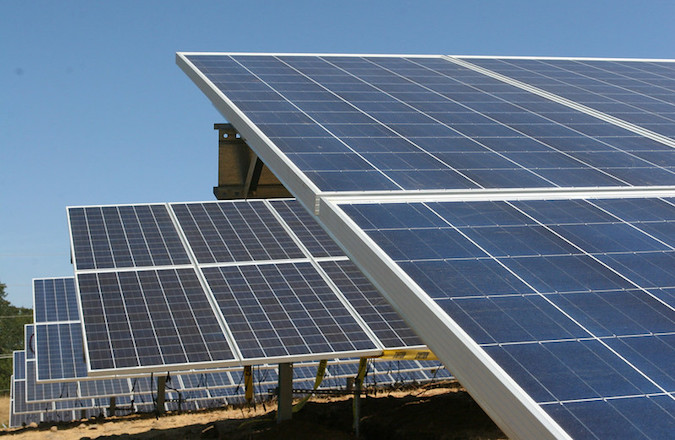The US Department of Solar Energy Technologies Office (SETO) and the National Renewable Energy Laboratory (NREL) have recently released a study exploring the role of solar energy technologies in decarbonizing the US electric grid. The Solar Future Study [1] is the most comprehensive review of the potential role of solar in decarbonizing the US electricity grid and broader energy system to date and claims solar power could provide 40% of the US’s electricity by 2035.
The full Solar Future Study can be found here.

Figure 1: Solar Park [3]
The Study
The study is based on analysis and modelling undertaken by the National Renewable Energy Laboratory, which envisions deep grid decarbonisation by 2035 (driven by the emission reduction target set by the Biden Administration) and explores how this could extend decarbonization to the broader energy system (the electric grid plus all direct fuel use in buildings, transportation, and industry) through 2050.
Solar energy technologies — primarily photovoltaics (PV) and concentrating solar power (CSP) — are specifically highlighted by this study as playing a key role in grid decarbonization. PV technologies are particularly important due to its many benefits including being the lowest-cost form of electricity generation; its cost-effective scalability; and its ability to decarbonize electricity end uses such as buildings, industry, and transportation.
To explore the role solar will have in the decarbonization of the U.S. electric grid, the study considers and models three core scenarios:
- Reference – This scenario outlines a ‘business-as-usual’ future, which includes existing state and federal clean energy policies but lacks a comprehensive effort to decarbonise the grid.
- Decarbonization (Decarb) – This scenario assumes more aggressive cost-reduction projections than the Reference scenario for solar as well as other renewable and energy storage technologies, but it uses standard future projections for electricity demand.
- Decarbonization with Electrification (Decarb+E) – This scenario goes further by including large-scale electrification of end uses. The study also analyses the potential for solar to contribute to a future with more complete decarbonization of the US energy system by 2050, although this analysis is simplified in comparison to the grid-decarbonization analysis and therefore entails greater uncertainty.
The Outcomes
Under the reference scenario, installed solar capacity still increases seven times by 2050, compared to 2005 levels. This results in a decline in grid emissions by 45% by 2035 and 61% by 2050. This is possible without a concerted policy effort due to market forces and technology advances that will drive significant deployment of solar and other clean energy technologies. Of course, this is not sufficient in meeting the emission reduction targets set by the Biden Administration.
Under the Decarb and Decarb+E scenarios, deep decarbonization of the grid leads to more extensive solar deployment, extensive deployment of wind and energy storage, and significant expansions of the U.S. transmission system. By 2035, the decarbonization scenarios both show cumulative solar deployment of 760–1,000 GW, increasing to 1,050–1,570 GW by 2050. The remainder of the electricity demand will be largely met by other zero-carbon resources.
The modelled energy mix of the decarbonization scenarios in 2035 and 2050 are set out in the table below.

Figure 2: Modelled electricity mix under the decarbonization scenarios
The Decarb+E scenario also forecasts decarbonization of the broader US energy system through large-scale electrification of buildings, transportation, and industry. In this scenario, electricity demand grows by about 30% from 2020 to 2035, owing to electrification of fuel-based building demands (e.g., heating), vehicles, and industrial processes. Electricity demand increases by an additional 34% from 2035 to 2050. By 2050, all these electrified sectors are powered by zero-carbon electricity. In this scenario, the combination of grid decarbonization and electrification abates more than 100% of grid CO2 emissions relative to 2005 levels.
Conclusion
President Biden currently faces tough opposition to his $1.75 trillion Build Back Better framework [2] for social and climate spending bill. Yet, without supportive policies, the decarbonization scenarios set out in the study are unlikely to become a reality, and emissions from the grid won’t fall rapidly enough for the US to become fully carbon-free domestic electricity industry by 2035.
About Pager Power
Pager Power has undertaken over 700 glint and glare assessments for solar and building projects in the US, the UK, and Internationally. If you require a glint and glare assessment or any assistance on your projects, please get in touch.
References
[1] U.S. Department of Energy Solar Energy Technologies Office and National Renewable Energy Laboratory, 2021. Solar Futures Study. [online] Energy.gov. Available at: <https://www.energy.gov/sites/default/files/2021-09/Solar%20Futures%20Study.pdf [Accessed 3 November 2021].
[2] The White House. 2021. The Build Back Better Framework | The White House. [online] Available at: <https://www.whitehouse.gov/build-back-better/> [Accessed 3 November 2021].
[3] Portland General Electric (August 2015) from flickr.com. Last accessed on: 3rd November 2021. Available at: https://www.flickr.com/photos/portlandgeneralelectric/21655620080



